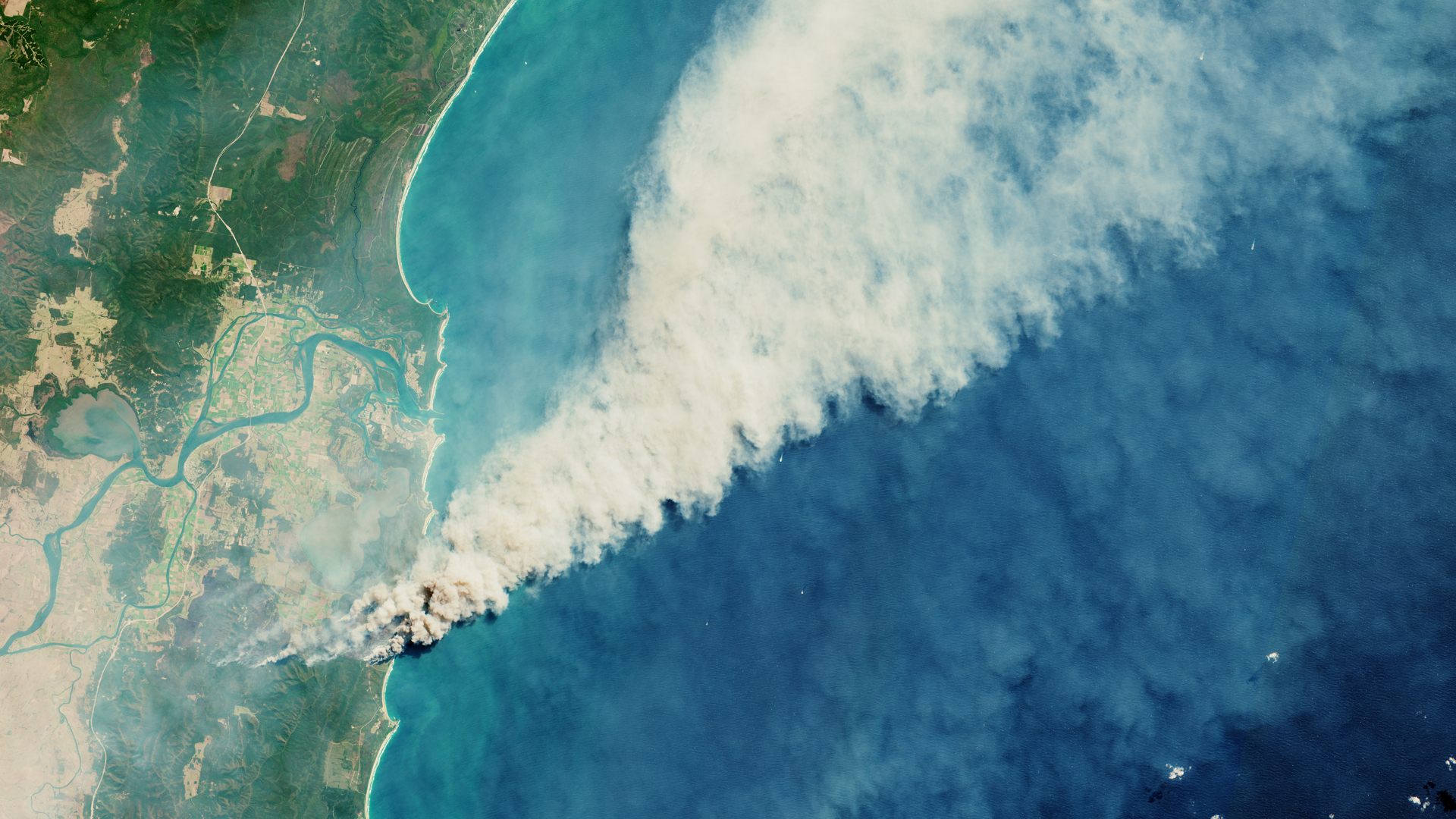Satellites watch Australian wildfires trigger CO2 booms and ocean algal blooms
Wildfires can't burn the ocean, but here's how they're connected.

Wildfires can affect the oceans and satellites can see it all unfold.
Australian wildfires released more than twice as much carbon dioxide in the 2019-2020 season than expected, scientists are realizing based on new analysis of satellite data. And the emissions likely triggered vast algal blooms in the Southern Ocean covering an area the size of the Sahara Desert. That's according to two new studies that use satellite data to show the complicated ways in which Earth is responding to climate change in an era of worsening wildfires.
"Our results provide strong evidence that iron from wildfires can fertilize the oceans, potentially leading to a significant increase in carbon uptake by phytoplankton," Nicolas Cassar, a biogeochemist at Duke University in North Carolina and co-author of the second study, told Space.com in an email.
Related: The devastating wildfires of 2021 are breaking records and satellites are tracking it all
See more: Australia's deadly wildfires in photos: The view from space
The unprecedented 2019-2020 Australian wildfire season, dubbed the "black summer" killed or displaced 3 billion animals according to ABC News, and the bushfire smoke claimed nearly 450 lives.
In Southeast Australia, the wildfires were both intense and extensive. About 28,570 square miles (74,000 square kilometers) — roughly 2.5 times the area of Belgium — of eucalyptus forests in the coastal regions of Victoria and New South Wales burned during the wildfire season of the 2019-2020 Southern Hemisphere summer.
Droughts driven by climate change are causing an increase in both the frequency and intensity of wildfires. These wildfires are a global problem since these devastating events release huge swaths of carbon dioxide into the atmosphere — driving further climate change, raising global temperatures and increasing the subsequent risk of wildfires, potentially triggering a perpetual feedback loop, according to the World Resources Institute, a nonprofit organization focused on environmental issues.
Breaking space news, the latest updates on rocket launches, skywatching events and more!
Those relationships make it important to know just how much carbon dioxide is released during wildfires, but estimating these emissions is no easy task. Fortunately, satellites can help. The researchers used the Tropospheric Monitoring Instrument (TROPOMI) onboard the Copernicus Sentinel-5 Precursor satellite. The instrument has been gathering data on carbon monoxide levels since 2018.
"We were stunned by the clear images it provided of atmospheric carbon monoxide concentrations from small and large wildfires around the world," Ivar van der Velde, an atmospheric scientist at SRON Netherlands Institute for Space Research and lead author of one of the new studies, told Space.com in an email.
Van der Velde and his colleagues calculated that around 715 teragrams of carbon dioxide (approximately 788 million tons or 715 billion kilograms) were released in just three months between November 2019 and January 2020. This is twice the amount of carbon dioxide that had previously been suggested from previous fire inventory estimates and surpasses Australia's normal annual bushfire and fossil fuel emissions by 80%, according to the new research.
"The question that now arises is what will happen to this CO2 [carbon dioxide] in the long term," van der Velde wrote. "The fires were so large that rapid recovery of the affected forests is more difficult, therefore it is likely that part of the emitted CO2 won't be compensated quickly by CO2 uptake during regrowth."
Even if Australia's vegetation can't grow fast enough to pull all that carbon dioxide back out of the atmosphere quickly, the new research suggests that another phenomenon may help.
Related: Astronaut watches California wildfires spewing smoke from space (photos)
The effects of the Australian wildfires weren't only felt in the locally scorched areas but may have also triggered blooms of phytoplankton — microscopic plants found in watery environments — thousands of miles away in the Southern Ocean, according to a separate independent study also published in Nature.
Extensive phytoplankton blooms covering an area approximately the size of the Sahara Desert — more than 3.6 million square miles (9.4 million square kilometers) — were found downwind of the wildfires in the Southern Ocean, according to Joan Llort, a marine biogeochemist at the Barcelona Supercomputing Center, and study co-leader.
This vast algal bloom event caught the researchers' attention as it occurred in a part of the ocean not normally associated with such activity. "The response was observed in an oceanic region that usually holds a very low concentration of phytoplankton, a bit like an oceanic desert," Llort told Space.com in an email.
The research team believes the plankton blooms may have been triggered by aerosols released from the Australian wildfires. The aerosols carried nutrients — such as iron — great distances before reaching the waters of the Southern Ocean, where iron is usually scarce. The nutrient delivery then fertilized the waters, prompting far-reaching phytoplankton blooms containing high concentrations of chlorophyll (phytoplankton, like land plants contain chlorophyll to turn sunlight into energy).
The researchers monitored aerosol plumes using datasets from the Copernicus Atmosphere Monitoring Service (CAMS), part of the European Union's Earth observation program Copernicus which includes aerosol observations made by NASA's Moderate Resolution Imaging Spectroradiometer (MODIS). The study found that some aerosols and gases released from the bushfires reached altitudes of up to 10 miles (16 km).
The researchers then compared aerosol observations to ocean chlorophyll concentrations (indicative of phytoplankton) recorded during a multi-sensor record spanning 22 years created by the Ocean Color Climate Change Initiative project and found that peaks in the concentration of black carbon (soot) were followed by peaks in chlorophyll concentrations a few days to weeks later. Additional chlorophyll measurements were taken directly by biogeochemical Argo floats and were confirmed to be phytoplankton.
These blooms can provide a beneficial environmental service. Phytoplankton can help to remove carbon dioxide from the atmosphere, as these tiny organisms — just like land plants — consume carbon dioxide during photosynthesis. According to NASA Earth Observatory, "phytoplankton are responsible for most of the transfer of carbon dioxide from the atmosphere to the ocean."
These microorganisms not only help to remove carbon dioxide from the atmosphere but also benefit the marine ecosystem as a valuable food source. "In open water of the ocean, as the ones where we observed this phenomena, phytoplankton blooms provide the very first source of food," Llort told Space.com. "The organic matter produced like this indirectly feeds all marina fauna, from zooplankton up to whales and sharks."
The two studies not only highlight the significance of wildfires on atmospheric carbon dioxide concentrations but also the potential knock-on effects in ocean ecosystems.
"Given the number of regions around the world that are being currently affected by large wildfires, it is plausible to think that other marine ecosystems might be affected by wildfires smoke," Llort wrote. "The question now is which are these ecosystems and which type of response we can expect in them."
Both the carbon dioxide release from Australian fires and the widespread phytoplankton blooms research were described in new studies published Wednesday (Sept. 15) in the journal Nature.
You can follow Daisy Dobrijevic on Twitter at @DaisyDobrijevic. Follow us on Twitter @Spacedotcom and on Facebook.
Join our Space Forums to keep talking space on the latest missions, night sky and more! And if you have a news tip, correction or comment, let us know at: community@space.com.

Daisy Dobrijevic joined Space.com in February 2022 having previously worked for our sister publication All About Space magazine as a staff writer. Before joining us, Daisy completed an editorial internship with the BBC Sky at Night Magazine and worked at the National Space Centre in Leicester, U.K., where she enjoyed communicating space science to the public. In 2021, Daisy completed a PhD in plant physiology and also holds a Master's in Environmental Science, she is currently based in Nottingham, U.K. Daisy is passionate about all things space, with a penchant for solar activity and space weather. She has a strong interest in astrotourism and loves nothing more than a good northern lights chase!

